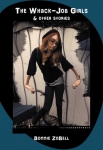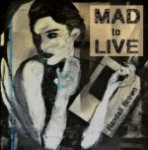By Bonnie ZoBell
Part of an ongoing series by Bonnie ZoBell, entitled “Creating and Publishing a Fiction Chapbook. This originally appeared in Flash Fiction Chronicles.
I’ll confess right here and now that I’m not an expert on getting chapbooks published. This article started as a chronicle to tell friends about the process I went through when my chapbook, The Whack-Job Girls–due out on March 1st–was accepted for publication by 
What is a Chapbook?
Believe me, my mother doesn’t know anything about chapbooks, but I’ve found there are writers who don’t, either, so I’ll give the best explanation I can and others can add to this. I’ll also be interviewing chapbook editors as part of this series, so I’ll be curious to hear what they say, too.
Poetry chapbooks have been around for a long time; only in more recent years have people started making fiction chapbooks as well. Poetry has always been perfect for this form since most poems are fairly short. Because these books are often between 18 and 50 pages, you can print a good representation of a person’s fiction as well. Now that people are writing a lot of flash fiction, a flash-fiction collection (which is what mine is) works great in the chapbook format, too. In fact, sometimes I’ve found it hard to read an extremely long book of flash because there’s too much starting and stopping. People are now also publishing novellas as chapbooks and collections of three full-length stories.
Print on Demand (POD)
 My book will be published as Print on Demand. What this means is that a press will print fewer books (maybe 100-300) to start with and then more as the need arises. Some chapbook publishers only publish a small number of books and stop there.
My book will be published as Print on Demand. What this means is that a press will print fewer books (maybe 100-300) to start with and then more as the need arises. Some chapbook publishers only publish a small number of books and stop there.
Mine will also be made into an e-book. If enough copies of the chapbook are sold, it will then be made into a paperback. If I make any money at all, it won’t be until after a certain number of copies have sold, which I believe is the norm. Apparently, plenty of people never make any money at these because they don’t put enough work into trying to help sell them.
My opinion is that if you’re into fiction or poetry to make money, you need to get a grip and find a new art. Quadruple that for chapbooks. Possibly you can make money writing elevator music since it gets played over and over again. Not everyone will agree with this.
My real point in getting a chapbook published is to pull all my flashes into a form so people can read my work. Also, it might lift my profile a little to help me get other things published.
E-Chapbooks
 I know very little about presses that do e-book-only chapbooks, so I hope others will say more below in the comments. There are definite advantages to these—you can use as much color and as many visual images as you like because you don’t have to worry about the cost of printing. You will never run out and can send them to anybody, any time you’d like so folks can read your work. While I’ve read and been impressed by these, the one I’m most familiar with is Bev Jackson’s The Loose Fish Chronicles, which was done by Wordrunner echapbooks. What I like about hers is that besides reading her prose (which is gorgeous), we get to see a lot of photos since this chapbook is a memoir. We also get to learn more about Bev Jackson and the fact that, for instance, she paints, too, and we get to see some of her paintings. It’s a great experience.
I know very little about presses that do e-book-only chapbooks, so I hope others will say more below in the comments. There are definite advantages to these—you can use as much color and as many visual images as you like because you don’t have to worry about the cost of printing. You will never run out and can send them to anybody, any time you’d like so folks can read your work. While I’ve read and been impressed by these, the one I’m most familiar with is Bev Jackson’s The Loose Fish Chronicles, which was done by Wordrunner echapbooks. What I like about hers is that besides reading her prose (which is gorgeous), we get to see a lot of photos since this chapbook is a memoir. We also get to learn more about Bev Jackson and the fact that, for instance, she paints, too, and we get to see some of her paintings. It’s a great experience.
 There are also Kyle Hemmings’ e-chapbooks, the most recent, I believe, being Anime Junkie published by CCD Magazine in conjunction with Scars Publications. This book is colorful and artfully done, and most importantly, brimming with Hemmings’ delectable prose.
There are also Kyle Hemmings’ e-chapbooks, the most recent, I believe, being Anime Junkie published by CCD Magazine in conjunction with Scars Publications. This book is colorful and artfully done, and most importantly, brimming with Hemmings’ delectable prose.
How to Put a Chapbook Together
Always a good question, especially since it has a lot of different answers. One editor rejected my chapbook because he didn’t think the stories were connected enough. Others presses have loved the subtle way they’re all connected. Some presses don’t care whether the stories are connected or not. I love Kathy Fish’s idea about putting all of her different stories around a table and then walking around the table herself until she gets some ideas about organization. I’d like to try that, if I could just get my tables cleared off. See Kathy’s beautiful, “undomesticated” fictions in her chapbook, Wild Life, out with Matter Press.
Randall Brown and others have really interesting ideas about organizing the stories into different distinct sections. Love to hear more about that. See Randall’s immensely popular and amazing Mad to Live at PS Books. (An informative aside about Randall’s publishing of his chapbook is that it won first place in Flume Press’s Chapbook Contest, the limited edition book completely sold out in a month, and the publisher didn’t do reprints. The book was then reprinted as a deluxe edition with more stories in it by PS Books, where it is now in its second printing.)
publisher didn’t do reprints. The book was then reprinted as a deluxe edition with more stories in it by PS Books, where it is now in its second printing.)
Selecting the Stories
After exploring the chapbooks of others, what I did to organize my own was to first list all of what I thought were my best flashes—which is hard to be objective about. Then I kept looking through them and typing out all the titles and a blurb describing each, trying to see some kind of theme running through. Finally, I came up with the idea (suggested by the title of the story “The Whack-Job Girls,” which was my favorite title) that I could put together a chapbook in which all of the women in the stories felt disconnected or alienated, like they didn’t fit into the world—some funny and some not so funny. After that, I removed all the stories from the list with a male p.o.v. and all that stories that I didn’t think fit that theme, including some that I thought were my best. I reconsidered those I thought did fit this theme and rewrote others.
Arranging the Stories
In terms of arranging the stories in the book, I’ve heard you should put your best story first, one of your best at the end, and another in the middle. I tried to place several of my favorites as the first few. But you also have to think about not wanting two stories in a row about, say, domestic abuse. I didn’t even realize I had two stories on that subject until they ended up next to each other in one of my collections. So I made sure they were far apart since that’s not the subject of the book.
Getting Feedback
When I had a version of the collection I liked, I traded comments with a friend who was also writing a chapbook. Because we were more concerned about getting feedback on the order of the stories than the stories themselves and because it’s hard to get this kind of feedback unless the other person wants the same done for her book and is immersed in thinking about organization, our primary goal was to comment only on that with just a few notes about the stories themselves. With this agreement, which I highly recommend, we were able to read each other’s collections quickly and get someone else’s input on the layout.
Finding a Publisher
 This important topic is coming soon in FFC’s ongoing chapbook series, but here are a few bits of advice until then.
This important topic is coming soon in FFC’s ongoing chapbook series, but here are a few bits of advice until then.
Kathy Fish: “Take some time to figure out what you most want or need in a publisher, then do your homework. Find the press that will meet your needs best as they are not all alike. If you want a publisher that will help you promote your book, look for those who promote their books/authors very visibly via social media. Is the visual aesthetic most important? The quality of the finished chapbook? Purchase chapbooks from various publishers and compare the level of care they put into the production of their books. Do you admire and respect the work of the other authors this press has published? And so on.”
Randall Brown: “Read the offerings from the press(es) to whom you are submitting your work. Mention in the cover letter why you think you and your work would be a good fit.”

Very well organized and helpful. Thanks
Thank you, Bonnie. (I came to your site by way of the Masters Review Chapbook Open.) The segments on organization–whether thematic or otherwise–are valuable, as is the suggestion of pairing up with another author of a similar chapbook. Motivation is everything, and if its particular form is held mutually then all the better!